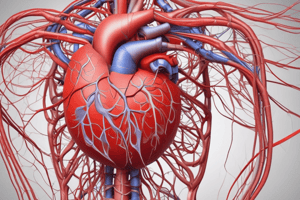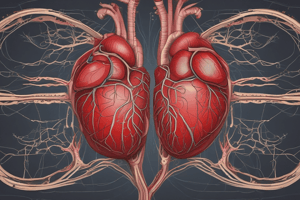Podcast
Questions and Answers
¿Cuál es la función del nodo sinoatrial (SA) en el sistema de conducción eléctrica del corazón?
¿Cuál es la función del nodo sinoatrial (SA) en el sistema de conducción eléctrica del corazón?
- Regula la frecuencia cardíaca en función del ejercicio físico
- Transmite el impulso eléctrico desde el nodo AV a los ventrículos
- Conecta las fibras cardíacas para permitir la contracción coordinada
- Genera un impulso eléctrico a una frecuencia de 60-100 ppm (correct)
¿Cuál es el tipo de músculo que se encuentra en el corazón?
¿Cuál es el tipo de músculo que se encuentra en el corazón?
- Músculo estriado voluntario
- Músculo esquelético
- Músculo estriado involuntario (correct)
- Músculo liso
¿Cuál es el propósito de los discos intercalados en las fibras musculares cardíacas?
¿Cuál es el propósito de los discos intercalados en las fibras musculares cardíacas?
- Controlar la presión arterial
- Permitir la contracción rápida de las fibras musculares
- Regular la frecuencia cardíaca
- Conectar las fibras musculares para permitir la contracción coordinada (correct)
¿Qué factor no afecta directamente la frecuencia cardíaca?
¿Qué factor no afecta directamente la frecuencia cardíaca?
¿Cuál es el nombre del grupo de fibras que transmiten el impulso eléctrico desde el nodo AV a los ventrículos?
¿Cuál es el nombre del grupo de fibras que transmiten el impulso eléctrico desde el nodo AV a los ventrículos?
¿Cuál es la unidad de medida del gasto cardíaco?
¿Cuál es la unidad de medida del gasto cardíaco?
¿Cuál sistema nervioso aumenta la frecuencia cardíaca y la contractilidad a través de la liberación de norepinefrina?
¿Cuál sistema nervioso aumenta la frecuencia cardíaca y la contractilidad a través de la liberación de norepinefrina?
¿Cuál es el rol de los baroreceptores en la regulación de la presión arterial?
¿Cuál es el rol de los baroreceptores en la regulación de la presión arterial?
¿Cuál es el papel del sistema nervioso autónomo en la regulación de la frecuencia cardíaca?
¿Cuál es el papel del sistema nervioso autónomo en la regulación de la frecuencia cardíaca?
¿Cuál es el papel de los riñones en la regulación de la presión arterial?
¿Cuál es el papel de los riñones en la regulación de la presión arterial?
¿Cuál es la frecuencia cardíaca intrínseca del corazón?
¿Cuál es la frecuencia cardíaca intrínseca del corazón?
Study Notes
Cardiac Muscle Structure
- Striated, involuntary muscle: Cardiac muscle is a type of striated muscle that is under involuntary control.
- Branching fibers: Cardiac muscle fibers are branching, allowing for rapid transmission of electrical signals.
- Intercalated discs: Specialized regions that connect adjacent fibers, enabling coordinated contraction.
- T-tubules: Deep invaginations of the sarcolemma, allowing for rapid transmission of electrical signals.
Electrical Conduction System
- SA node (sinoatrial node): The natural pacemaker, generating an electrical impulse at a rate of 60-100 bpm.
- AV node (atrioventricular node): Relays the electrical impulse from the SA node to the ventricles, causing contraction.
- Bundle of His: A group of specialized fibers that transmit the electrical impulse from the AV node to the ventricles.
- Purkinje fibers: Specialized fibers that rapidly transmit the electrical impulse to the ventricular muscle.
Cardiac Output
- Stroke volume: The volume of blood pumped by the heart per beat.
- Heart rate: The number of times the heart beats per minute.
- Cardiac output: The product of stroke volume and heart rate, measured in liters per minute (L/min).
- Factors affecting cardiac output: Heart rate, stroke volume, preload, afterload, and contractility.
Blood Pressure Control
- Short-term regulation: Mediated by the autonomic nervous system, which adjusts heart rate and vasodilation/constriction to maintain blood pressure.
- Long-term regulation: Mediated by the kidneys, which regulate blood volume and vasoconstriction to maintain blood pressure.
- Baroreceptors: Specialized sensors that detect changes in blood pressure and send signals to the brain for adjustment.
Heart Rate Regulation
- Autonomic nervous system: The sympathetic and parasympathetic nervous systems work together to regulate heart rate.
- Sympathetic nervous system: Increases heart rate and contractility through the release of norepinephrine.
- Parasympathetic nervous system: Decreases heart rate through the release of acetylcholine.
- Intrinsic control: The heart's intrinsic rate, which is around 100 bpm.
Studying That Suits You
Use AI to generate personalized quizzes and flashcards to suit your learning preferences.
Description
Explore the structure and function of cardiac muscle, the electrical conduction system, cardiac output, blood pressure control, and heart rate regulation in this comprehensive quiz.





